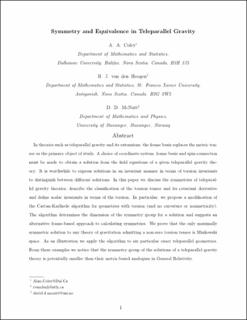| dc.contributor.author | Coley, Alan | |
| dc.contributor.author | van den Hoogen, Robert | |
| dc.contributor.author | McNutt, David Duncan | |
| dc.date.accessioned | 2021-02-10T11:57:27Z | |
| dc.date.available | 2021-02-10T11:57:27Z | |
| dc.date.created | 2020-09-22T12:16:44Z | |
| dc.date.issued | 2020-07 | |
| dc.identifier.citation | Coley, A.A., van den Hoogen, R.J., McNutt, D.D. (2020) Symmetry and Equivalence in Teleparallel Gravity. Journal of Mathematical Physics. 2020, 61(7), 072503. | en_US |
| dc.identifier.issn | 0022-2488 | |
| dc.identifier.uri | https://hdl.handle.net/11250/2727177 | |
| dc.description | This article may be downloaded for personal use only. Any other use requires prior permission of the author and AIP Publishing. This article appeared in Symmetry and Equivalence in Teleparallel Gravity. Journal of Mathematical Physics. 2020, 61(7), 072503. and may be found at https://aip.scitation.org/doi/10.1063/5.0003252. | en_US |
| dc.description.abstract | In theories such as teleparallel gravity and its extensions, the frame basis replaces the metric tensor as the primary object of study. A choice of coordinate system, frame basis, and spin-connection must be made to obtain a solution from the field equations of a given teleparallel gravity theory. It is worthwhile to express solutions in an invariant manner in terms of torsion invariants to distinguish between different solutions. In this paper, we discuss the symmetries of teleparallel gravity theories, describe the classification of the torsion tensor and its covariant derivative, and define scalar invariants in terms of the torsion. In particular, we propose a modification of the Cartan–Karlhede algorithm for geometries with torsion (and no curvature or nonmetricity). The algorithm determines the dimension of the symmetry group for a solution and suggests an alternative frame-based approach to calculating symmetries. We prove that the only maximally symmetric solution to any theory of gravitation admitting a non-zero torsion tensor is Minkowski space. As an illustration, we apply the algorithm to six particular exact teleparallel geometries. From these examples, we notice that the symmetry group of the solutions of a teleparallel gravity theory is potentially smaller than their metric-based analogs in general relativity. | en_US |
| dc.language.iso | eng | en_US |
| dc.publisher | AIP Publishing LLC | en_US |
| dc.subject | fysikk | en_US |
| dc.title | Symmetry and Equivalence in Teleparallel Gravity | en_US |
| dc.type | Peer reviewed | en_US |
| dc.type | Journal article | en_US |
| dc.description.version | acceptedVersion | en_US |
| dc.rights.holder | © 2020 AIP Publishing LLC | en_US |
| dc.subject.nsi | VDP::Matematikk og Naturvitenskap: 400::Fysikk: 430 | en_US |
| dc.source.volume | 61 | en_US |
| dc.source.journal | Journal of Mathematical Physics | en_US |
| dc.source.issue | 7 | en_US |
| dc.identifier.doi | 10.1063/5.0003252 | |
| dc.identifier.cristin | 1832056 | |
| dc.source.articlenumber | 072503 | en_US |
| cristin.ispublished | true | |
| cristin.fulltext | postprint | |
| cristin.qualitycode | 1 | |
